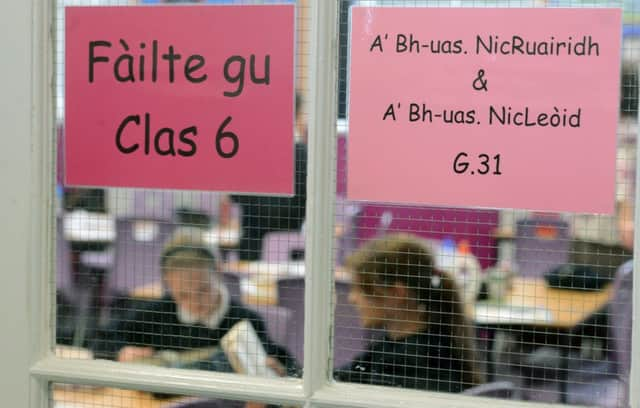Growth of Gaelic education hailed a success


Bòrd na Gàidhlig’s annual report for 2013/14 highlights a rise in numbers seeking to be educated in the language.
Gaelic-medium education has risen by 6.1 per cent at primary school level, with the number of children entering into primary one rising by 13 per cent to 486 entrants.
Advertisement
Hide AdHowever, this still falls short of the 800 new entrants being sought by 2017.
The number of pupils also doing Gaelic-medium education at secondary level rose by 7 per cent, totalling 1181.
Further growth was seen the early years sector with the number of parent and toddler groups and playgroups increasing from 80 to 93, thus furthering the potential of increasing the number of entrants to GME in the coming years.
But the Western Isles is still proving to be a sore point for the body, which supported by public funds.
Chief Executive Officer John Angus MacKay said: “2013/2014 was another positive year for the Bòrd with continued growth in Gaelic education, at all levels.
“The 2011 census results gave us very encouraging evidence that the number of Gaelic speakers in Scotland has almost stabilised since the census of 2001.
Advertisement
Hide AdThis is mainly due to the rise in Gaelic-medium education which has seen excellent growth since its inception in 1985. The trend shows that within the next ten years the long term decline of the language could be reversed.”
Chairman Iain Campbell added: “The results also showed that there had been a small increase in the number of people under 20 who could speak Gaelic.
Advertisement
Hide Ad“That in itself should give us hope and confidence as we look to the future.”
However, he admitted: “Although the figures in general were encouraging, the number of Gaelic speakers in rural area continues to decline, and especially in the Western Isles.
“This represents a very significant danger to the long-term viability of the language in Scotland.
“More work needs to be done in the island and rural communities to reverse this trend and create a healthier situation for Gaelic in these areas.”
The Bòrd meanwhile welcomed the new Gaelic schools which are to be opened in Portree and Fort William.
Mr Campbell added: “We are also pleased that the number of pupils in Gaelic Medium Education is steadily increasing.
Advertisement
Hide Ad“Another indication of the success of GME is the growing number of Gaelic schools that are being established across Scotland. These schools create a foundation for our language, for it is today’s young children who will keep Gaelic alive and flourishing in the future.
We have a busy year ahead, but at Bòrd na Gàidhlig we are fully confident of still further progress in achieving a secure future for Gaelic in Scotland.”
Advertisement
Hide AdThrough the course of the year the Bòrd dealt with 349 applications for funding from different organisations throughout the length and breadth of Scotland. 72 per cent however of the funding received by the Bòrd from the Scottish Government was distributed to others.
Minister for Scotland’s Languages Dr Alasdair Allan said: “Parents across the country have been clear that they recognise the benefits of a bilingual education for their children and the rolls for GME schools and units continue to grow.
“This support is one of the key reasons that the 2011 census showed that the number of Gaelic speakers under 20 had grown in the last decade and the historic decline in the number of speakers has slowed dramatically.
“These figures show that targeted investment is not only helping children excel at school; develop in a bilingual environment and understand Gaelic culture better, but that we are also encouraging Gaelic as a vibrant part of many of Scotland’s communities.
“We are currently consulting on the provision of GME across Scotland and will look at the successes so far and how we can continue to build on our achievements. It will reflect the views of parents, teachers and local authorities to develop a long-term, sustainable approach to delivering the bilingual opportunities families are calling for.
“I would like to congratulate the Bòrd on its work to promote Gaelic culture and to encourage the many community groups that are creating opportunities for speakers of all ages and backgrounds.”